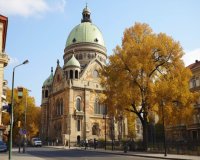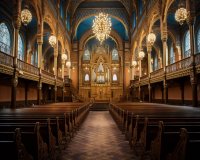The Impact of World War II on Budapest’s Jewish Community

The Impact of WWII on Budapest's Jewish Community
Budapest, the vibrant capital of Hungary, has a rich and diverse history, but one of the most poignant chapters in its past is the impact of World War II on its Jewish community. The city's Jewish population has faced numerous trials and tribulations throughout history, but the events of World War II left an indelible mark on Budapest and its Jewish inhabitants.
The Prelude to Tragedy
Before delving into the specific impact of World War II, it is essential to understand the historical context leading up to this dark period. Budapest has a long and storied Jewish heritage, with Jewish communities dating back centuries. In the late 19th and early 20th centuries, Budapest was home to a thriving Jewish population, contributing significantly to the city's cultural, economic, and intellectual life.
However, the rise of fascism and anti-Semitism in Europe in the 1930s cast a shadow over Budapest's Jewish community. Discriminatory laws, restrictions, and violence against Jews escalated, and the situation became increasingly precarious as World War II loomed on the horizon.
The Holocaust in Budapest
When World War II broke out, Hungary initially remained neutral, but in 1940, it joined the Axis Powers, aligning itself with Nazi Germany. This alliance had devastating consequences for Budapest's Jewish population. In 1944, Nazi forces occupied Hungary, and the systematic persecution of Jews intensified.
The Nazis, with the assistance of the Hungarian authorities, initiated mass deportations of Jews from Budapest to concentration camps, primarily Auschwitz. Thousands of innocent men, women, and children were forcibly removed from their homes, leading to a tragic loss of life and the shattering of families.
The Ghettoization of Budapest
One of the most notorious aspects of Budapest's wartime history was the establishment of the Budapest Ghetto in the city's seventh district. Enclosed by barbed wire and guarded by armed soldiers, this ghetto became a harrowing symbol of the oppression faced by Budapest's Jewish community. Conditions inside the ghetto were deplorable, with overcrowding, starvation, and disease rampant.
Despite the grim circumstances, acts of resistance and resilience within the ghetto were notable. Jewish leaders organized underground movements, and individuals helped each other to survive, demonstrating the enduring spirit of the community in the face of adversity.
The Liberation and Rebuilding
As Allied forces closed in on Budapest in early 1945, the city's Jewish population saw a glimmer of hope. The Red Army's liberation of Budapest in February marked the end of the Nazi occupation and the beginning of a new chapter for the Jewish community.
However, the city and its Jewish community faced immense challenges in the aftermath of the war. Budapest was in ruins, and the Jewish community had suffered immeasurable losses. Many survivors were left without homes or possessions.
Despite these hardships, Budapest's Jewish community began the process of rebuilding. Efforts to document the horrors of the Holocaust, commemorate the victims, and preserve the memory of the past became essential. The city's Jewish institutions, including synagogues and cultural centers, played a crucial role in this process of remembrance and renewal.
Legacy and Remembrance
Today, Budapest's Jewish community continues to thrive, albeit on a smaller scale than before World War II. The city's Jewish heritage is a testament to the resilience of a community that faced unimaginable suffering and loss. Memorials, museums, and educational initiatives serve as reminders of the past, ensuring that the memory of the Holocaust is never forgotten.
In conclusion, the impact of World War II on Budapest's Jewish community is a tragic chapter in the city's history. The Holocaust and its aftermath left scars that can still be felt today. However, the strength, resilience, and determination of Budapest's Jewish population have allowed the community to endure and rebuild, preserving its rich heritage and ensuring that the lessons of the past are never forgotten.
Budapest: Festive & Jewish Quarter Self-Guided Walking Tour
Visit the Jewish quarter of Budapest, home to ruin bars, historic landmarks, and Europe's largest synagogue, Dohány Street Synagogue. Explore the 7th District with your smartphone as your guide.
About this activity
Discover at your own pace the old Jewish quarter of Budapest, known today as the festive but also cultural and artistic district of the city! The only thing you need to explore for 1 hour? Your smartphone! The voice of a local guide will guide you throughout the visit and the stories will be triggered automatically as you go along. Start your tour whenever you want, alone or with friends, far from tourist groups...
During this 1h30 audio-guided tour, start your walk on the elegant Andrassy Avenue. Sometimes called the "Champs Élysées" of Budapest, it’s been a Unesco World Heritage Site since 2002. Then discover the communist period of Budapest by passing in front of the House of Terror. You will then continue on your way along Andrassy Avenue where many must-see places, stories and anecdotes await you. You will pass the first Budapest Department Store, admire the magnificent City Opera House and walk along the Hollywood Boulevard of Budapest.
Continue your journey by entering the Jewish quarter of Budapest to discover the largest Synagogue in Europe! You will understand why this district has nowadays lost part of its identity... You will pass by buildings such as the Monument of the Righteous or the Memorial Park which bear witness to the tragic history of the Jews in Budapest. You will then discover why today this district is especially known as a place for festivities and artistic and cultural events. You will learn for example the history of the famous ruin bars in Budapest! Many anecdotes will enrich your walk in the city.
A short stop at a terrace or a shop, a small craving? Resume the visit when you want, right where you paused. It's impossible to get lost. The guide provides clear audio directions and a map indicates clear directions to follow in real time. And if you take a wrong turn, the integrated geo-localization feature will get you back on track in no time! customize your itinerary as you wish, relax and enjoy a fun and entertaining tour of Castle district, at your own pace.
As all good things must come to an end, you will finish your visit with the most famous ruin bar of the city: the Szimpla Kert. A unique place to discover absolutely if you come in the district.
Includes:
- 1h30 audio-guided walking tour of the old Jewish quarter and the current festive district of the city
Meeting point
To start your audio-guided tour, go to https://rewindstories.com/en/activation/ and add your reservation number and email address to unlock the tour. Then download the Rewind application and create a new account with the same email address. Once you have arrived at the starting point, start the tour by clicking on the play button in the Rewind application.
Important information
Know before you go:
- An internet connection is required for the duration of the tour
- Follow the tour from your smartphone on the Rewind app
- For a better experience, it is recommended to bring headphones. If not, the sound will come out of the smartphone's speakers
- The tour launches at the starting point and won’t start from anywhere else
- You can activate pause at any time and resume the tour whenever you want
- This tour is available in English, French and Hungarian
- The visit take around 90 minutes
Save up to 10% From US$ 10.65 US$ 9.58 per person
Symbols of Resistance in Budapest's Jewish District
Budapest's Jewish District, also known as the 7th district, is a place steeped in history and rich in cultural significance. It has witnessed the ebb and flow of time, bearing witness to both moments of celebration and times of great adversity. Within this district, there are numerous symbols of resistance that stand as testaments to the resilience and strength of the Jewish community.
The Star of David
One of the most recognizable symbols of Judaism is the Star of David, also known as the Magen David. It consists of two interlocking equilateral triangles, creating a six-pointed star. This emblem has been a powerful symbol of Jewish identity for centuries. In Budapest's Jewish District, you can find the Star of David adorning synagogues, buildings, and even street art, serving as a reminder of the unyielding spirit of the Jewish people.
The Tree of Life
The Tree of Life, or Etz Chaim, is another significant symbol within Judaism. It represents the connection between all forms of creation and is often associated with wisdom, strength, and renewal. In the heart of Budapest's Jewish District, you'll find this symbol gracing the walls of synagogues, serving as a source of inspiration and hope for generations.
The Menorah
The Menorah, a seven-branched candelabrum, is a symbol deeply intertwined with Jewish tradition. It holds great symbolic value, representing light, wisdom, and divine presence. In the Jewish District of Budapest, you can encounter various representations of the Menorah, each carrying its own unique artistic expression.
The Memorial Stones
Scattered throughout the district are memorial stones, also known as Stolpersteine, a project initiated by German artist Gunter Demnig. These small brass plaques are set into the pavement, each bearing the name of a Holocaust victim along with their date of birth and the fate they met. They serve as a stark reminder of the atrocities committed during World War II and stand as a call to remember and never forget.
The Wall of Heroes
In the heart of Budapest's Jewish District lies the Wall of Heroes, a monument dedicated to those who resisted the oppression of the Nazis during World War II. This powerful tribute showcases the names of courageous individuals who took a stand against tyranny, often at great personal risk. It stands as a testament to the bravery and determination of those who fought for freedom.
Conclusion
Budapest's Jewish District is a place of profound historical significance, where symbols of resistance serve as reminders of the strength and resilience of the Jewish community. Each emblem, from the Star of David to the Memorial Stones, carries its own weight of meaning and history. These symbols stand as beacons of hope, urging us to remember the past and strive for a future free from oppression and prejudice.
Budapest Jewish Heritage Guided Tour: Explore Hungarian Jewish History
Discover the rich tapestry of Hungarian Jewish history and heritage on an enlightening walking tour through Budapest. Delve into significant landmarks, including the Dohany Street Synagogue, Jewish Museum, Holocaust Cemetery, and the poignant Raoul Wallenberg Memorial Park.
Tour Highlights
Embark on a journey through Jewish Budapest to witness its poignant history and architectural marvels. The itinerary includes:
- Exploration of the Pest Jewish Quarter and its historical significance
- Exterior visit to the remarkable Rumbach Street Synagogue
- Interior tour of the Dohány Street Synagogue, the largest in Europe
- Guided visit to the Jewish Museum showcasing photos, artworks, and religious artifacts
- Visit to the Holocaust Memorial, a somber reminder of the past
- Exploration of Raoul Wallenberg Memorial Park with its symbolic Tree of Life
Tour Experience
On this 90-minute guided walking tour, immerse yourself in Hungarian Jewish heritage and the tragic yet inspiring tales of the past. Gain insights into the local Jewish community's history and visit significant landmarks, all while absorbing the unique cultural ambiance.
What's Included
The tour includes entrance fees to key locations, allowing you to delve deep into the Hungarian Jewish heritage:
- Entrance to the Jewish Museum and its unique collection
- Access to the Dohány Street Synagogue, a masterpiece of architecture and history
- Entry to the poignant Raoul Wallenberg Memorial Park
- Visit to the Jewish Centre for an in-depth understanding of the Jewish Quarter
Customer Reviews
Based on 138 reviews, the tour has received an overall rating of 4.5 out of 5, highlighting the expertise of the guide, value for money, and exceptional service. Travelers commend the tour's educational and insightful narrative, offering a deep understanding of Hungary's history.
Important Information
For this tour, it's advisable to bring your passport or ID card and wear comfortable shoes. Please note that pets and large bags are not allowed for this excursion.
The Post-war Fates of Budapest's Jewish Community
Budapest, the capital of Hungary, holds a significant place in the history of Europe, especially when it comes to the Jewish community. The aftermath of World War II brought about profound changes in the lives of Budapest's Jewish population, and this article explores the post-war fates of this community.
Pre-war Jewish Life in Budapest
Before delving into the post-war era, it's essential to understand the vibrant Jewish community that existed in Budapest prior to World War II. The city had a thriving Jewish population, with synagogues, cultural institutions, and businesses contributing to its rich tapestry.
The Holocaust had a devastating impact on Budapest's Jews. In 1944, the city became the epicenter of the Hungarian Holocaust as the Nazi regime, with the help of Hungarian authorities, initiated the deportation of Jews to concentration camps. Thousands perished in these camps, while others endured unimaginable suffering.
Survival and Rebuilding
Despite the horrors of the Holocaust, some members of Budapest's Jewish community survived. After the war, they faced the daunting task of rebuilding their lives and their community. Many survivors found themselves displaced, and organizations like the Joint Distribution Committee played a crucial role in providing aid and support.
Rebuilding synagogues and Jewish cultural institutions became a symbol of resilience for Budapest's Jewish community. The Great Synagogue, one of the largest in the world, was restored to its former glory, serving as a powerful reminder of the community's enduring spirit.
The Communist Era
Following World War II, Hungary fell under Communist rule, significantly impacting Budapest's Jewish community. The Communist regime suppressed religious practices, leading to a decline in synagogue attendance and religious observance. However, Jewish cultural and social life continued underground, and some Jews played active roles in the Communist government.
Post-Communist Rejuvenation
With the fall of Communism in 1989, Budapest's Jewish community experienced a revival. Religious freedom was restored, allowing for the open practice of Judaism. Synagogues once again became centers of worship and cultural activities.
The city's Jewish community also actively engaged in preserving the memory of the Holocaust. The Holocaust Memorial Center was established to educate future generations about the atrocities of the past and promote tolerance and understanding.
Contemporary Budapest
Today, Budapest's Jewish community is a dynamic and integral part of the city's cultural fabric. It continues to thrive with synagogues, Jewish schools, cultural festivals, and kosher restaurants. The Jewish Quarter, once a neglected area, has transformed into a trendy district with a rich Jewish history.
Budapest's Jewish community plays a vital role in interfaith dialogue and fostering understanding among different religious groups in the city. They actively contribute to Hungary's diverse cultural heritage.
Conclusion
The post-war fates of Budapest's Jewish community have been marked by resilience, survival, and revival. From the horrors of the Holocaust to the challenges of Communist rule, the community has endured and thrived. Today, Budapest's Jewish community stands as a testament to the strength of the human spirit and the importance of preserving cultural heritage.






